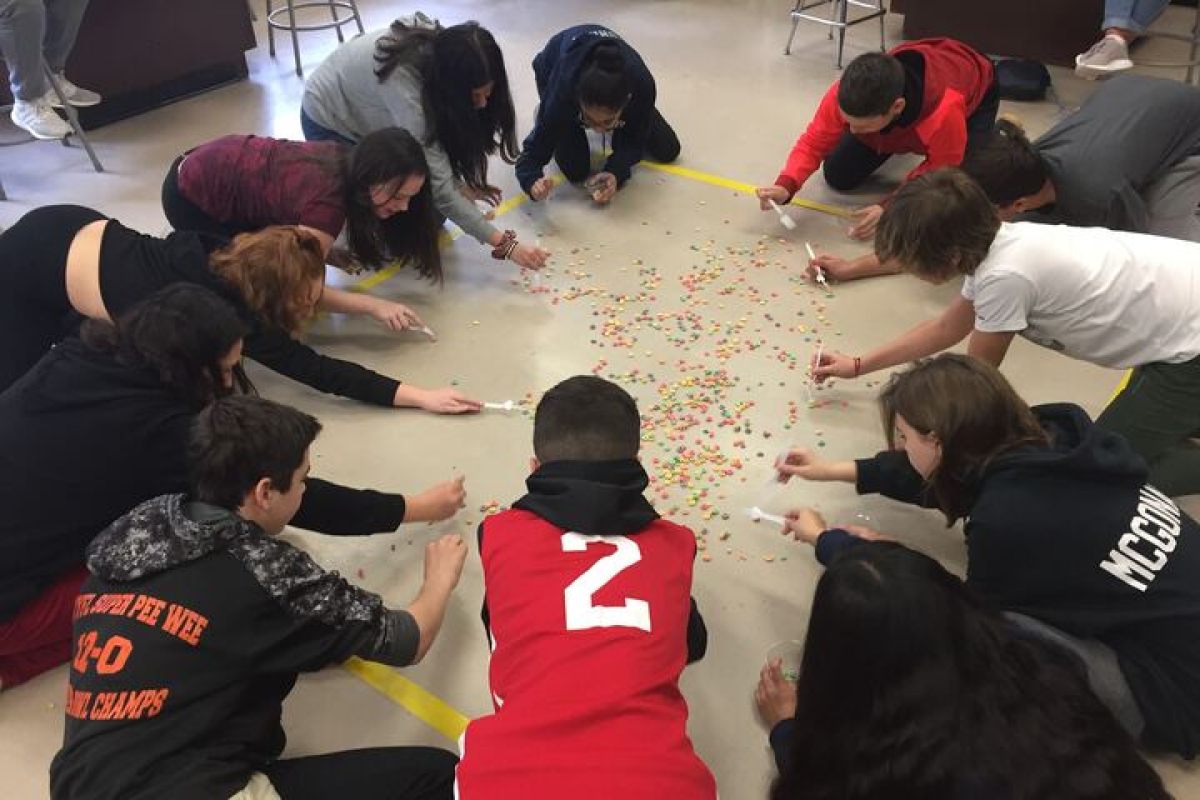
From putting our students’ work on a hall bulletin board to displaying their projects at a science fair, there are so many ways to celebrate student work, formally and informally. As teachers, you put so much work into sharing student work – and the payoffs are huge.
For students, the process of making their work “public” helps solidify learning and gives them a sense of accomplishment and confidence. Their work can educate and motivate their peers, as well.
For teachers, celebrations of student work are a record of our own accomplishments, and they can serve as a much-needed opportunity to reflect on the impact we have been making. Curated collections of student work can also become part of our professional portfolios to use in administrative evaluations and for career advancement.
As the school year wraps up, it can be challenging to find time and space to look back on all you and your class have accomplished. So In this article, we:
-
- Showcase inspiring student work from Mosa Mack users
-
- Explore ways of celebrating your own student work throughout the year and provide you with a free downloadable interactive template for a Science Yearbook, which allows you and your students to easily celebrate standout activities and projects.
1. OUR BULLETIN BOARD OF YOUR WORK
You work hard to implement amazing projects and we want to celebrate that.
We’ve seen students across the country create masterpieces of scientific exploration that reflect compelling inquiry, deep learning, and inspired problem-solving while also sparking fresh insight. So as part of our own ongoing “bulletin board,” we plan to feature as much standout work as possible, whether it’s a photo of a finished product or an action shot of the creation process. Send your favorite images along with the Mosa Mack unit and activity and any other details about the work that might help the images come alive.
Here is a showcase of some of our all-time favorite student classroom moments and creations.
City Resolution
How can you use states of matter to improve a local problem with the roads?
In the States of Matter Engineer, students use what they have learned about the different states of matter (including their properties and how the particles move) to design a solution to a widespread city problem, such as excessive potholes or the need for freshwater.
This group of students utilized their knowledge of the distinct properties of rainwater, asphalt, and crushed limestone to identify how potholes are formed and how they can be most effectively filled in. When they presented their final product to the class, their teacher said “I had such a deep understanding of their mastery of the content that I threw out their written final exam.”
Photo Caption: From the classroom of Demetrius Asekomeh in California
Plate Tectonics Measurement Device
Can you prove that tectonic plates are still moving?
In the Plate Tectonics Engineer, students are tasked with researching and designing new equipment to gather plate tectonic data to prove that the Earth’s plates are still moving.
After thoughtful planning and sketching, this student constructed a prototype device that straddles two adjacent tectonic plates and uses ground sensors to detect the plates’ movements. Their choice and crafting of materials brilliantly highlights the function of each part.

Photo caption: From the classroom of Stacen Hodgetts, Illinois
Tower Construction
Can you build the tallest tower?
In the Design Thinking Solve, students are challenged to construct the tallest free-standing tower capable of supporting a given mass (in this case, a marshmallow “observation tower”).
These students worked in groups, experimenting with a variety of shapes, structures, and construction methods, a hands-on test of strength, balance, height, sturdiness, and support. Afterwards, the groups compared tower designs and reflected on which steps of the design thinking process they utilized: from understanding the key problem to ideation, prototyping, testing, refining, and repeating.
Matter Separation
Can you help an artist separate her materials before her big presentation?
In the Matter and Its Interactions Engineer, students use their knowledge of matter to separate a mixture and use physical properties to identify each component of the mixture. This climactic hands-on activity is made more fun and urgent by a fictional narrative: “You have been contacted by a celebrated artist to help her solve a dire problem: her precious art supplies have been mixed together and need to be separated so she can complete an artwork for an upcoming show.”
Here, students are relishing the experience of removing metal shavings from liquid paint with a magnet.
Product Development for People with Disabilities
Can you use sound or light waves to help someone who is deaf or blind?
In the Waves Engineer, students use their knowledge of waves to design a product that can help deaf people detect sound waves or help blind people detect light waves.
Having learned that different colors emit different wavelengths, these students designed a bracelet to help blind people safely cross the street. The device would detect the color of a traffic light and then emit vibrations specific to that color to indicate to the wearer whether they should walk or wait. The students incorporated LittleBits into their design, which was a creative way to demonstrate the functions of and connections between the device’s parts.
Classroom of Chris Sedgwick, Louisiana
Field Guide
Can you find physical similarities between plants and animals?
In the Plant and Animal Structures Lab, students go through a series of discovery activities, including creating a field guide that compares the structures and function of animals and plants. Two students created masterpieces that their teachers couldn’t wait to share:
-
- One student cleverly juxtaposed a plant’s roots with a bear’s legs to articulate a fundamental contrast between how the organisms obtain food: one by staying in place and the other through movement.
-
- Another student used a beautiful illustration to note that a rose plant’s thorns and a porcupine’s quills were similar because each one “protects it from predators and keeps them from getting eaten.”
Photo Caption: From the classrooms of Dana Burrow, Missouri
Survival Game
If you were a wild animal, would you survive?
In the Adaptations Solve, students play a survival game to discover how different traits in a population increase some individuals’ probability of surviving and reproducing. Students play the role of a feeding finch by using forks with a different number of prongs to represent their beak types. They then must pluck up as many Wild Loop “insects” as they can.
This heart-racing competition has the whole class excited and engaged, internalizing through action how adaptations impact survival.
New Trait Creation
Can you take genes from one organism and add them to another?
In the Mutations Engineer, students explore the exciting frontier of CRISPR, a new gene editing tool used to stick new genes into cells to create new traits for an organism.
To demonstrate their plan to use a sea cucumber’s gene for regeneration to help a shark regrow its fin, this group of students created a PowerPoint presentation that powerfully articulates their plan, reflects thorough background research, and skillfully balances text, imagery, and graphics.
Photo Caption: From the classroom of Patricia Wahlsten, New Jersey
Photosynthesis Song
Will this song get stuck in your head?
In the Photosynthesis Solve, students create a vocabulary manipulative and then dive into an animated mystery of an ailing fern, which ends in a cliffhanger for students to solve themselves.
This group of students has zeroed in on a catchy song in the animation, which offers clues to the mystery’s solution and helps with understanding key terms and concepts. Their teacher observed them and told us that “the kids are obsessed with the Chloroplast song this year.”
2. HOW TO CELEBRATE YOUR STUDENTS’ WORK
Use Digital Tools
In addition to hanging up your students’ work or having them share it with the class, there are many other creative ways you can celebrate student work. These digital tools are especially useful when you’re short on time for students to present live.
-
- Google Slides allows students to design slides to showcase their project – this becomes a digital portfolio of student work.
-
- We created a Digital Science Yearbook you can use. This digital book helps you celebrate and capture favorite student work samples and memories.
-
- Google Slides allows students to design slides to showcase their project – this becomes a digital portfolio of student work.
-
- Padlet helps you to create a “gallery walk” where students share their final projects to the board and their classmates do peer reviews for each other.
-
- Flip allows students to share work, recorded videos, and more.
Give Students the Stage
The more we can involve students themselves in the showcasing of their work, the more engaged and motivated they’ll be (and it will take some stress off of us teachers).
-
- Find ways for students to act as “presenters,” bringing alive the project or activity for others.
-
- Have them tell the story of creating the work, the “why” of the project and challenges and questions they faced along the way, as well as the conclusions they drew or lessons they learned.
Broaden the Audience
When students are able to celebrate their work beyond the classroom, they can see it in a bigger context with real-world relevance.
-
- Look for opportunities for students to present to different science classes; 7th graders presenting to 6th graders; a “What’s New in Science” monthly newsletter or demo table in the cafeteria.
-
- Develop ways for students to share work at home with their families, like adding a “teach this at home” component to a project or activity.
-
- Beyond that, you might help students share their work in a wider community setting, inviting seniors to class, presenting at the local library, using their work to cultivate relationships with real-life experts.
We can’t wait to hear how you share your student work and utilize your 

Leave a Reply